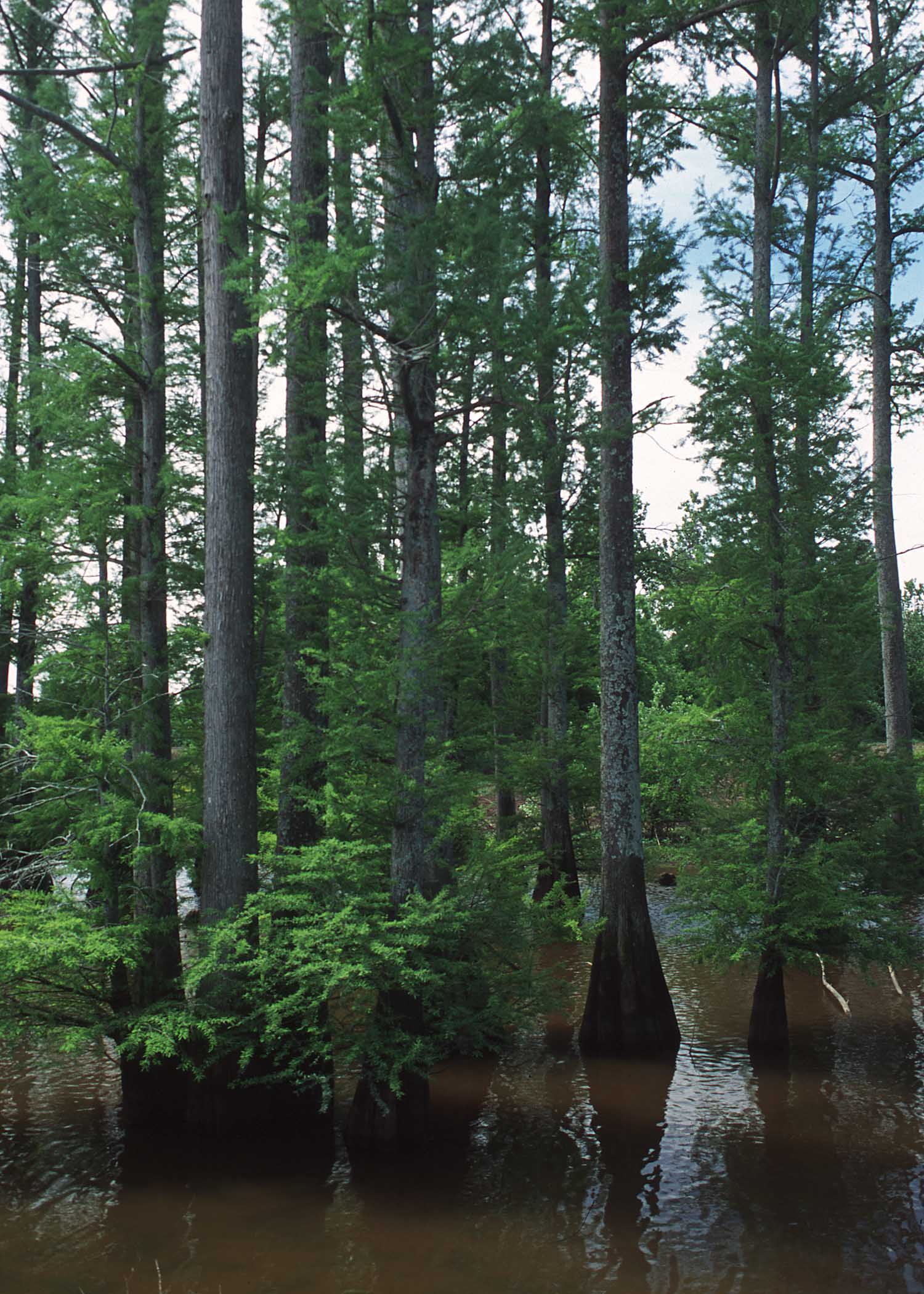- Taxodium
Taxobox
name = "Taxodium"

image_width = 270px
image_caption = Bald Cypress forest
in a centralMississippi lake
regnum =Plant ae
divisio =Pinophyta
classis = Pinopsida
ordo =Pinales
familia =Cupressaceae
genus = "Taxodium"
genus_authority = Rich.
subdivision_ranks = Species
subdivision = "Taxodium ascendens " - Pond Cypress "Taxodium distichum " - Bald Cypress "Taxodium mucronatum " - Montezuma Cypress"Taxodium" is a
genus of one to threespecies (depending on taxonomic opinion) of extremely flood-tolerantconifer s in the cypress family,Cupressaceae . Within the family, "Taxodium" is most closely related to Chinese Swamp Cypress ("Glyptostrobus pensilis") and Sugi ("Cryptomeria japonica").Species of "Taxodium" occur in the southern part of the
North America n continent and aredeciduous in the north and semi-evergreen toevergreen in the south. They are largetree s, reaching 100-150 feet tall (30-45 m) and 2-3 m (exceptionally 11 m) trunk diameter. The needle-like leaves, 0.5-2 cm long, are borne spirally on the shoots, twisted at the base so as to appear in two flat rows on either side of the shoot. The cones are globose, 2-3.5 cm diameter, with 10-25 scales, each scale with 1-2seed s; they are mature in 7-9 months after pollination, when they disintegrate to release the seeds. The male (pollen) cones are produced in pendulous racemes, and shed their pollen in early spring.Species
The three taxa of "Taxodium" are treated here as distinct species, though some
botanist s treat them in just one or two species, with the others considered as varieties of the first described. The three are distinct inecology , growing in different environments, but hybridise where they meet.*"
Taxodium distichum " - Bald CypressThe most familiar species in the genus is the Bald Cypress, native to much of the southeasternUnited States , fromDelaware toTexas and inland up theMississippi River to southernIndiana . It occurs mainly along rivers with silt-rich flood deposits.*"
Taxodium ascendens " - Pond CypressThe Pond Cypress occurs within the range of Bald Cypress, but only on the southeastern coastal plain fromNorth Carolina toLouisiana . It occurs in still blackwater rivers, ponds and swamps without silt-rich flood deposits.*"
Taxodium mucronatum " - Montezuma CypressThe Montezuma Cypress occurs from theRio Grande south to the highlands of southernMexico , and differs from the other two species in being substantially evergreen. A specimen at Santa Maria del Tule in Oaxaca, theÁrbol del Tule , is 43 m tall and has the greatest trunk thickness of any living tree, 11.42 m in diameter. It is a riparian tree, occurring on the banks of streams and rivers, not in swamps like the Bald and Pond cypress.Uses
The trees are especially prized for their
wood , of which the "heartwood" is extremely rot and termite resistant, with the notable exception of the host-specificPecky Rot fungus ("Stereum taxodii"), which causes some damaged trees to become hollow and thus useless for timber. "A biochemical called cypressene is believed to act as a natural preservative in the heartwood, but it takes many decades to build up in the wood, making lumber cut from old-growth trees much more resistant to decay than lumber from younger trees". - Sternberg, G., "Native Trees for North American Landscapes" pp. 476. Bald Cypress wood was much used in former days in southeastern US for shingles. The shreddedbark of these trees is used as amulch , although the current harvest rate for this product is not sustainable and is causing substantial environmental damage especially in the south where cutting boundaries are not being followed.Evolution
In earth's history "Taxodium" was widespread. It is known since the
Jurassic and can be found asfossil e.g. in layers fromTertiary times.External links and references
* [http://www.conifers.org/cu/tax/index.htm Gymnosperm Database - Taxodium]
* [http://www.audubon.org/local/sanctuary/corkscrew/ Corkscrew Swamp Sanctuary website]
*National Audubon Society, undated. "Corkscrew Swamp Sanctuary. A Companion Field Guide". Artype Inc., Ft. Myers. 25 p.
*Sternberg, G., (2004) "Native Trees for North American Landscapes" pp. 476. Timber Press, Inc.
Wikimedia Foundation. 2010.
